Structural, Optical, and Magnetic Studies of the Metallic Lead Effect on MnO2-Pb-PbO2 Vitroceramics
Abstract
:1. Introduction
2. Experimental Procedure
3. Results and Discussion
3.1. Structural Investigation by X-ray Diffraction (XRD)
3.2. Structural Investigations by IR Spectroscopy
3.3. Structural Investigation by UV–Vis Spectroscopy
3.4. Optical Band Gap Energy
3.5. Structural Investigation by EPR Spectroscopy
4. Conclusions
Author Contributions
Funding
Institutional Review Board Statement
Informed Consent Statement
Data Availability Statement
Conflicts of Interest
References
- Padyak, B.V.; Kindrat, I.I.; Kulyk, Y.O.; Mundry, S.I.; Drzewiecki, A.; Hordieiev, Y.S.; Goles, V.I.; Lisiecki, R. Local structure, spectroscopic properties and intrinsic photoluminescence of the un-doped lead-containing glasses of different composition. Mater. Sci. Eng. B 2022, 278, 115655. [Google Scholar] [CrossRef]
- Rada, S.; Rus, L.; Rada, M.; Zagrai, M.; Culea, E.; Rusu, T. Compositional dependence of structure, optical and electrochemical properties of antimony (III) oxide doped lead glasses and vitroceramics. Ceram. Int. 2014, 40, 15711–15716. [Google Scholar] [CrossRef]
- Rada, S.; Zagrai, M.; Rada, M.; Magerusan, L.; Popa, A.; Suciu, R.; Macavei, S.; Suciu, M. Structure, electrochemical characterizations and the role of copper oxide in lead-lead dioxide glasses and vitroceramics. J. Non-Cryst. Solids 2018, 491, 55–63. [Google Scholar] [CrossRef]
- Krupych, O.; Lototska, I.M.; Say, A.; Boyko, V.; Goleus, V.; Hordieiev, Y.; Vlokh, R. Characterization of PbO-B2O3-GeO2-La2O3 and PbO-B2O3-SiO2-ZnO glasses: Refractive, acoustic, photo-elastic and acousto-optic properties. Ukr. J. Phys. Opt. 2020, 21, 47–56. [Google Scholar] [CrossRef]
- Tillman, I.J.; Dettmann, M.A.; Herrig, V.; Thune, Z.L.; Zieser, A.J.; Michalek, S.F.; Been, M.O.; Szewczyk, M.M.M.; Koster, H.J.; Wilkinson, C.J.; et al. High-density scintillating glasses for a proton imaging detector. Opt. Mater. 2017, 68, 58–62. [Google Scholar] [CrossRef]
- Chanthima, N.; Kaewkhao, J.; Limsuwan, P. Study of photon interactions and shielding properties of silicate glasses containing Bi2O3, BaO and PbO in the energy region of 1keV to 100 GeV. Ann. Nucl. Energy 2012, 41, 119–124. [Google Scholar] [CrossRef]
- Rada, S.; Zagrai, M.; Rada, M.; Culea, E.; Bolundut, L.; Unguresan, M.L.; Pica, M. Spectroscopic and electrochemical investigations of lead-lead dioxide glasses and vitroceramics with applications for recharcheable lead-acid batteries. Ceram. Int. 2016, 42, 3921–3929. [Google Scholar] [CrossRef]
- Rada, S.; Unguresan, M.; Zhang, J. XANES, EXAFS, voltammetric and microhardness study of manganese dioxide—Lead—Lead dioxide vitroceramics. Materials 2022, 15, 6522. [Google Scholar] [CrossRef] [PubMed]
- Yusub, S.; Rao, P.S.; Rao, D.K. Ionic conductivity, dielectric and optical properties of lithium lead borophosphate glasses combined with manganese ions. J. Alloys Compd. 2016, 663, 708–717. [Google Scholar] [CrossRef]
- Khajonrit, J.; Montreeuppathum, A.; Kidkhunthod, P.; Chanlek, N.; Poo-arpon, Y.; Pinitsoontorn, S.; Maensiri, S. New transparent materials for applications as supercapacitors: Manganese—Lithium—Borate glasses. J. Alloys Compd. 2018, 763, 199–208. [Google Scholar] [CrossRef]
- Song, J.; Wu, D.; Zhang, C.; Ming, Q.; Imanzadeh, M. Investigation of mixed alkali effect on the DC electrical conductivity, structural, and physical properties of phosphate glasses containing MnO2. J. Phys. Chem. Solids 2022, 167, 110759. [Google Scholar] [CrossRef]
- Zagrai, M.; Rus, L.; Rada, S.; Stan, S.; Rada, M.; Bolundut, L.; Pica, M.E.; Culea, E. Lead metallic–lead dioxide glasses as alternative of immobilization of the radioactive wastes. J. Non-Cryst. Solids 2014, 405, 129–134. [Google Scholar] [CrossRef]
- Chelcea, R.; Rada, S.; Culea, E.; Coroiu, I. The change of the local environment of MnO incorporated in the lead-germanate glassy network. J. Non-Cryst. Solids 2016, 433, 45–50. [Google Scholar] [CrossRef]
- Hidayat, R.; Sangwaranatee, N.; Kaewkhao, J.; Srisittipokakun, N. Optical and physical properties of MnO2 doped soda-lime- barium-silicate glasses with industrial scales. Mater. Today Proc. 2018, 5, 15040–15043. [Google Scholar] [CrossRef]
- Hameed, A.; Balakrishna, A.; Srinivas, B.; Chandrasekhar, M.; Shareefuddin, M.; Chary, M.N. Influence of manganese ions on physical and spectroscopic properties of mixed alkali-alkaline earth oxide borate glasses. Optik 2021, 246, 167810. [Google Scholar] [CrossRef]
- Renata, S.M.; José, P.D.; Claudio, J.M.; Igor, A.A.S.; Christian, R.; Marcelo, N. Optical and structural studies of Mn+2 doped SbPO4-ZnO-PbO glasses. J. Braz. Chem. Soc. 2015, 12, 2607–2614. [Google Scholar]
- Algradee, M.A.; Elbashar, Y.H.; Alwany, A.B.; Hassan, H.H.; El-Mallawany, E. Impact of Y2O3 on the physical, bonding, dispersion and dielectric properties of Li2O-ZnO-P2O5 glasses. Mater. Sci. Semicond. Process. 2022, 140, 106362. [Google Scholar] [CrossRef]
- Toloman, D.; Giurgiu, L.M.; Ardelean, I. EPR investigations of calcium phosphate glasses containing manganese ions. Physica B 2009, 404, 4198–4201. [Google Scholar] [CrossRef]
- Kesavulu, C.R.; Muralidhara, R.S.; Rao, J.L.; Anavekar, R.V.; Chakradhar, R.P.S. EPR and photoluminescence studies on lithium-potassium borophosphate glasses doped with Mn+2 ions. J. Alloys Compd. 2009, 486, 46–50. [Google Scholar] [CrossRef]
- Chang, C.H.; Svedruz, D.; Ozarowski, A.; Walker, L.; Yeagle, G.; Britt, R.D.; Angerhofer, A.; Richards, N.G.J. EPR spectroscopic characterization of the manganese center and a free radical in the oxalate decarboxylase reaction: Identification of a tyrosyl radical during turnover. J. Biol. Chem. 2004, 279, 52840–52849. [Google Scholar] [CrossRef] [PubMed] [Green Version]
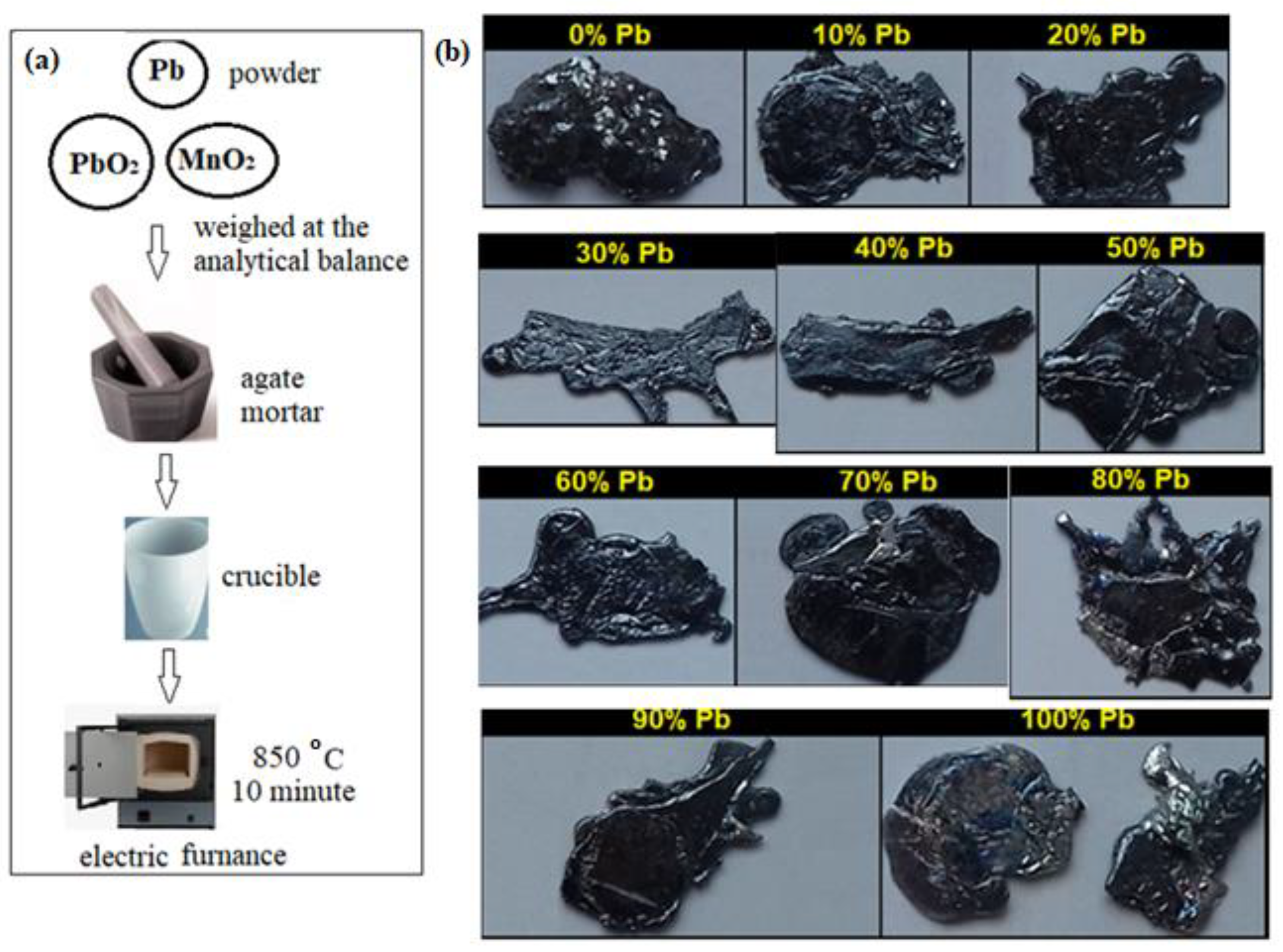
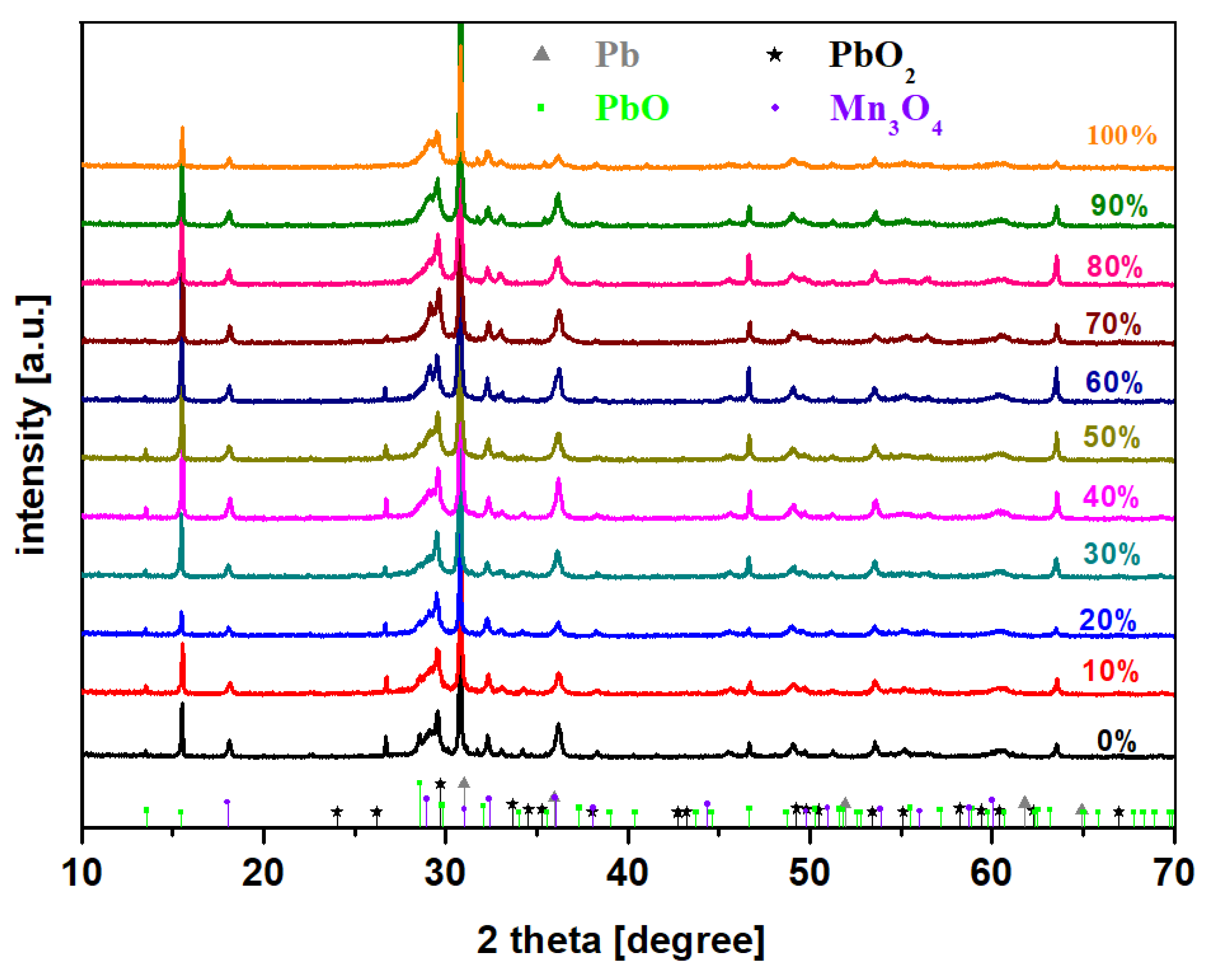

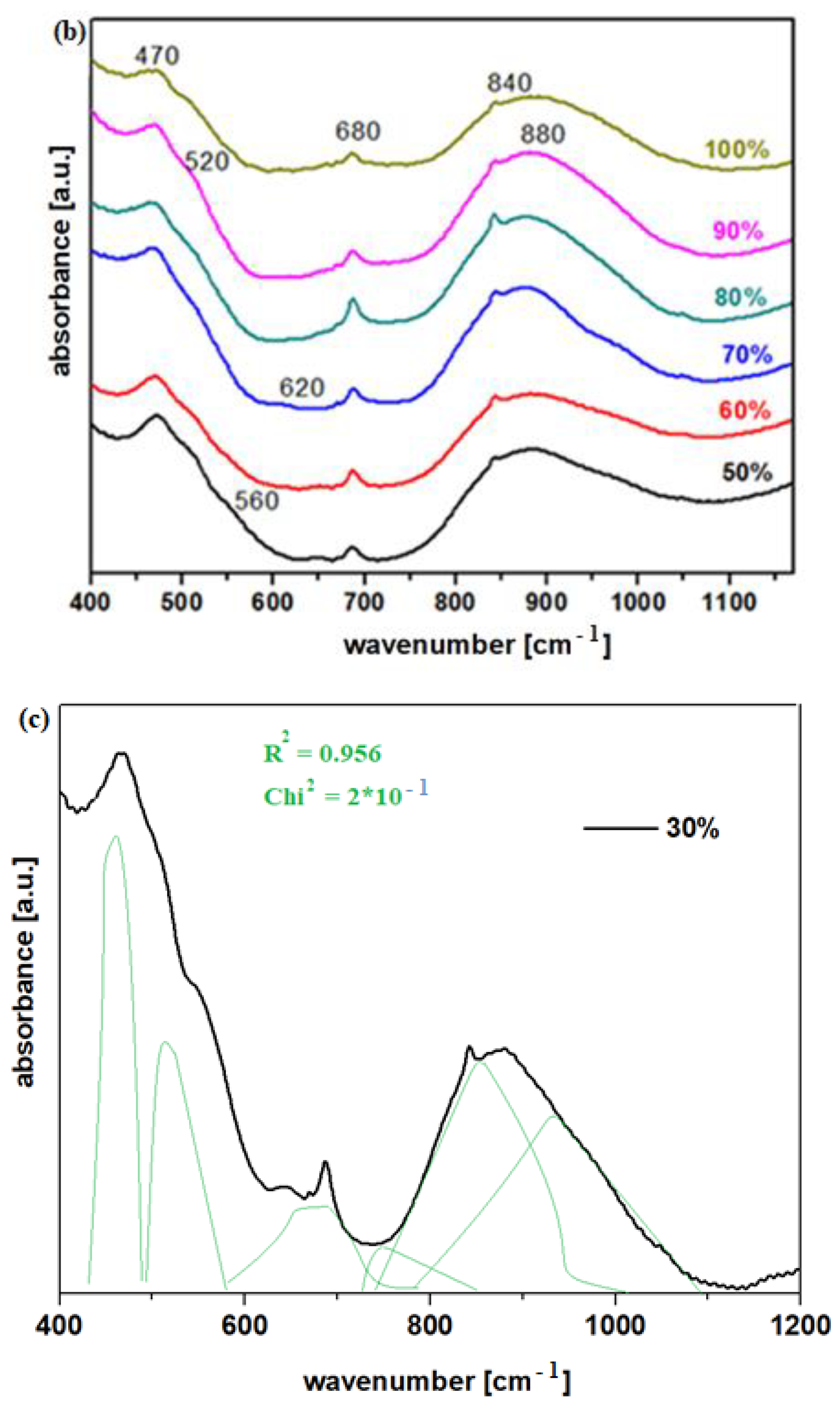
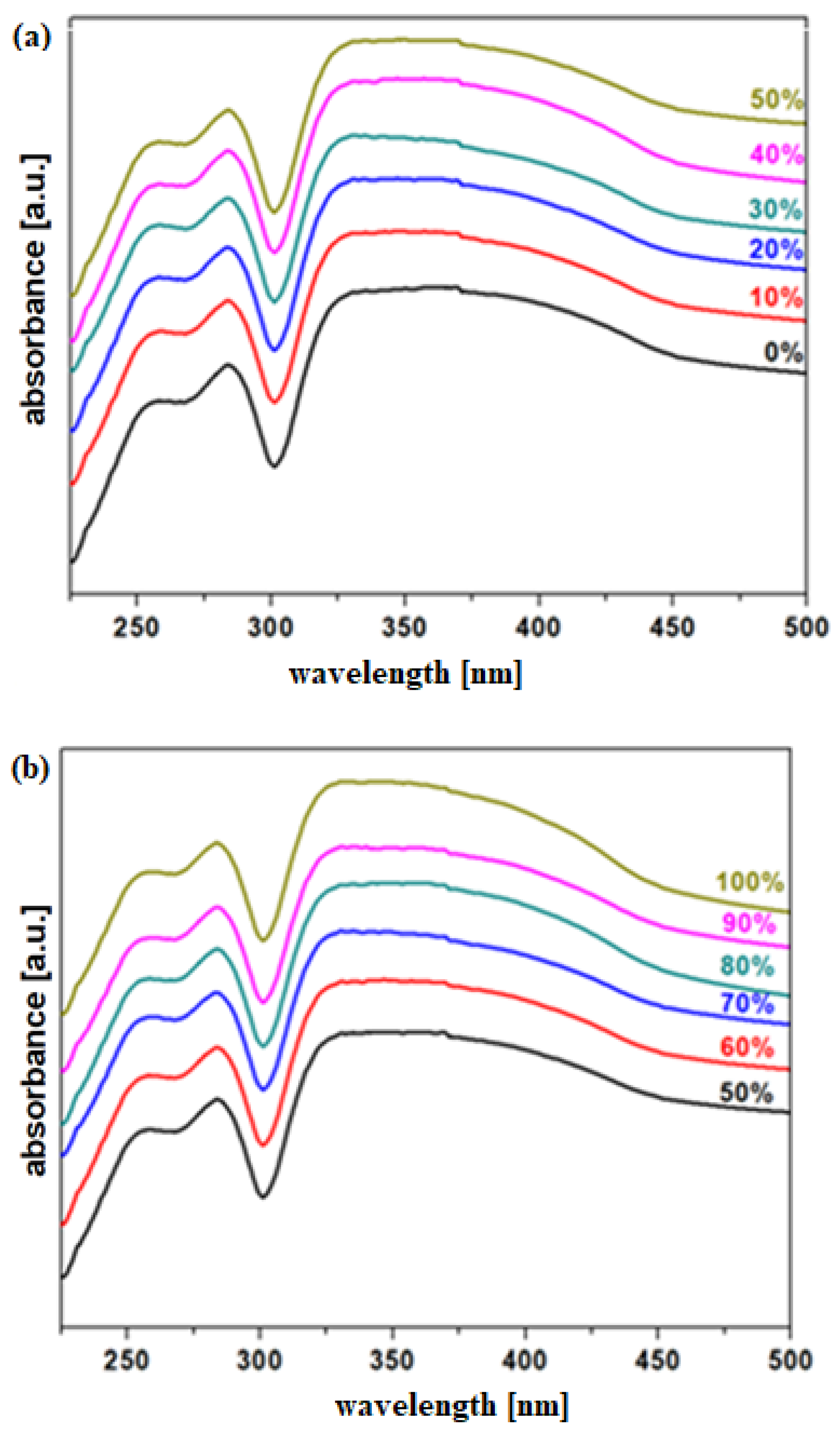
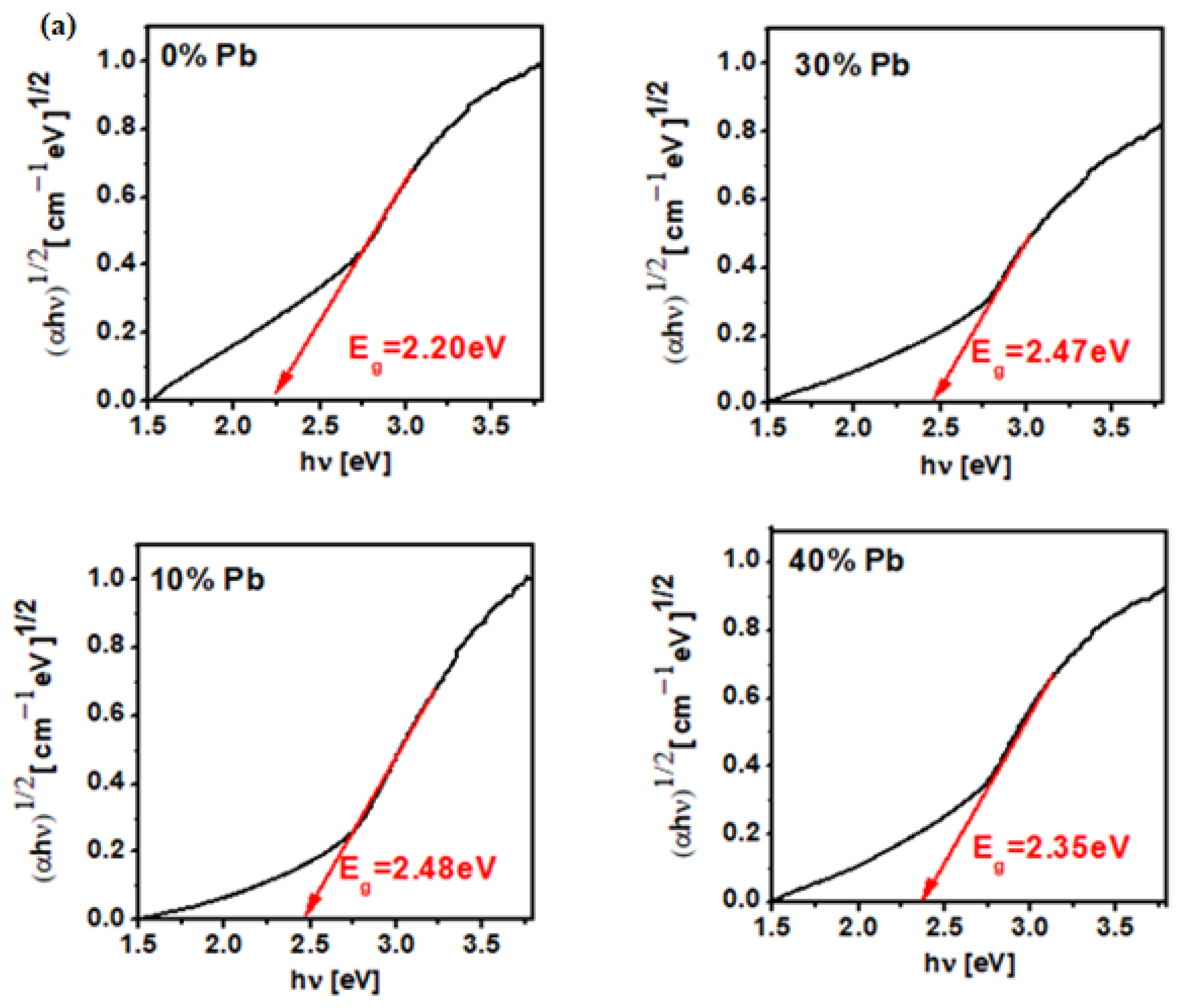
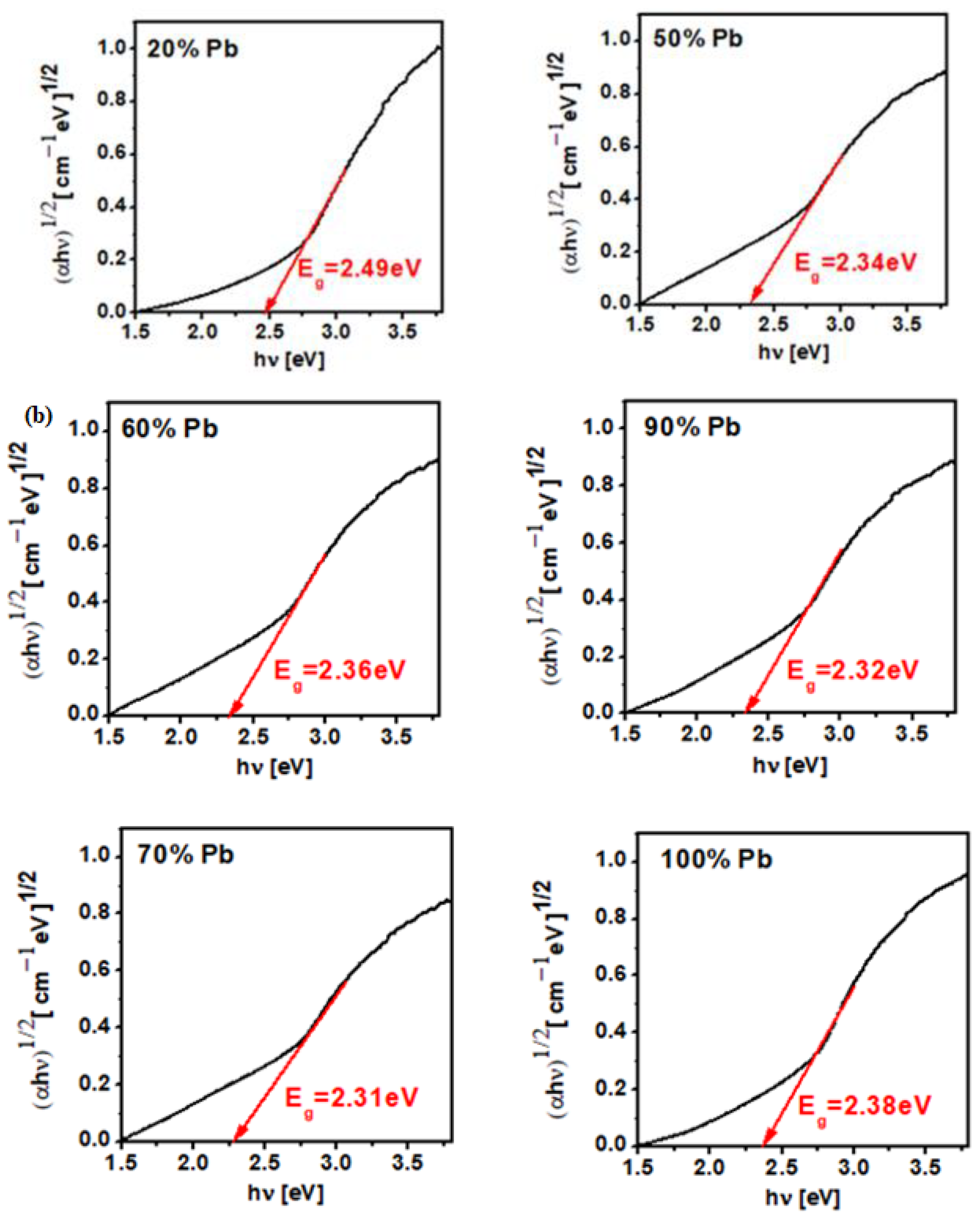
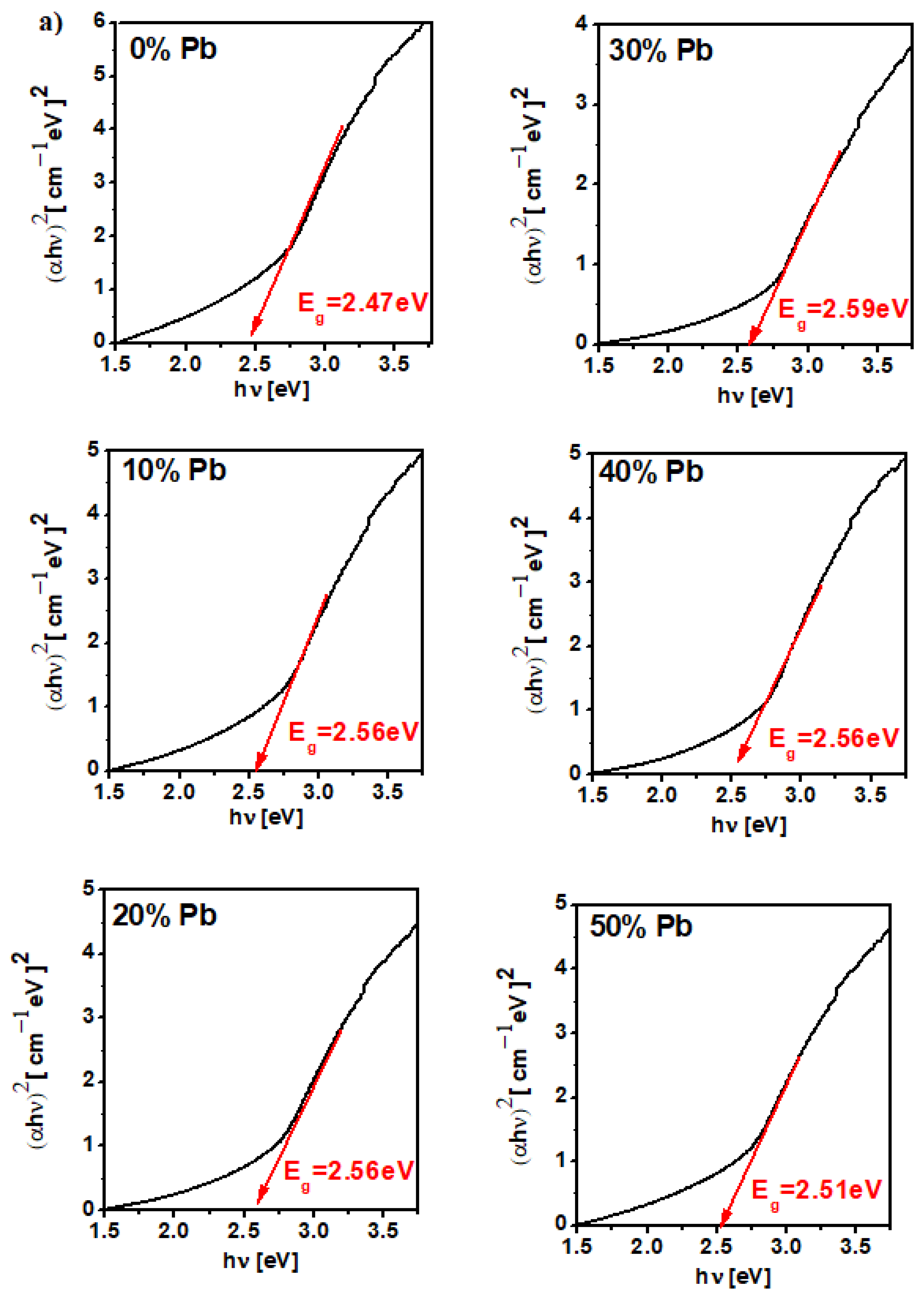
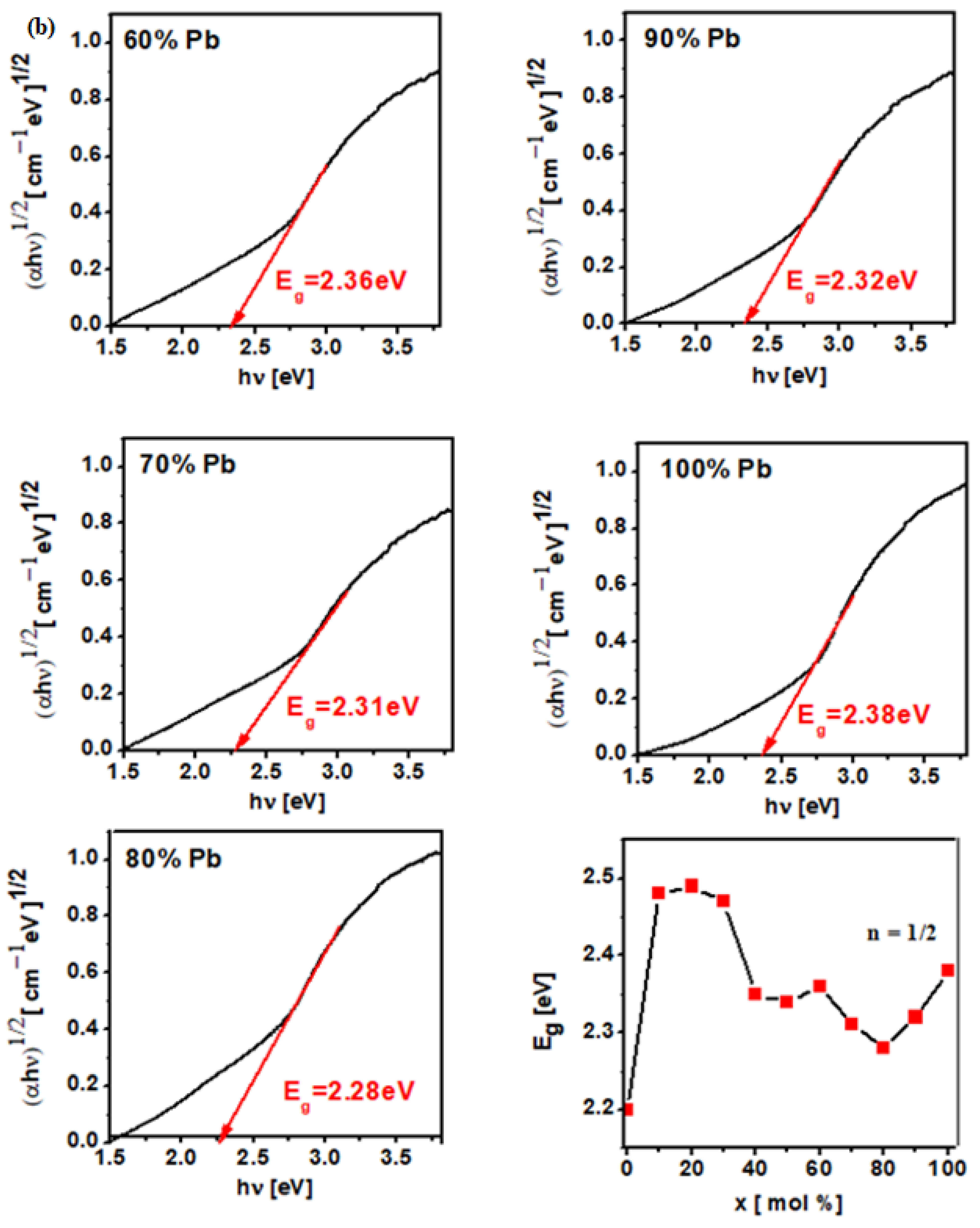
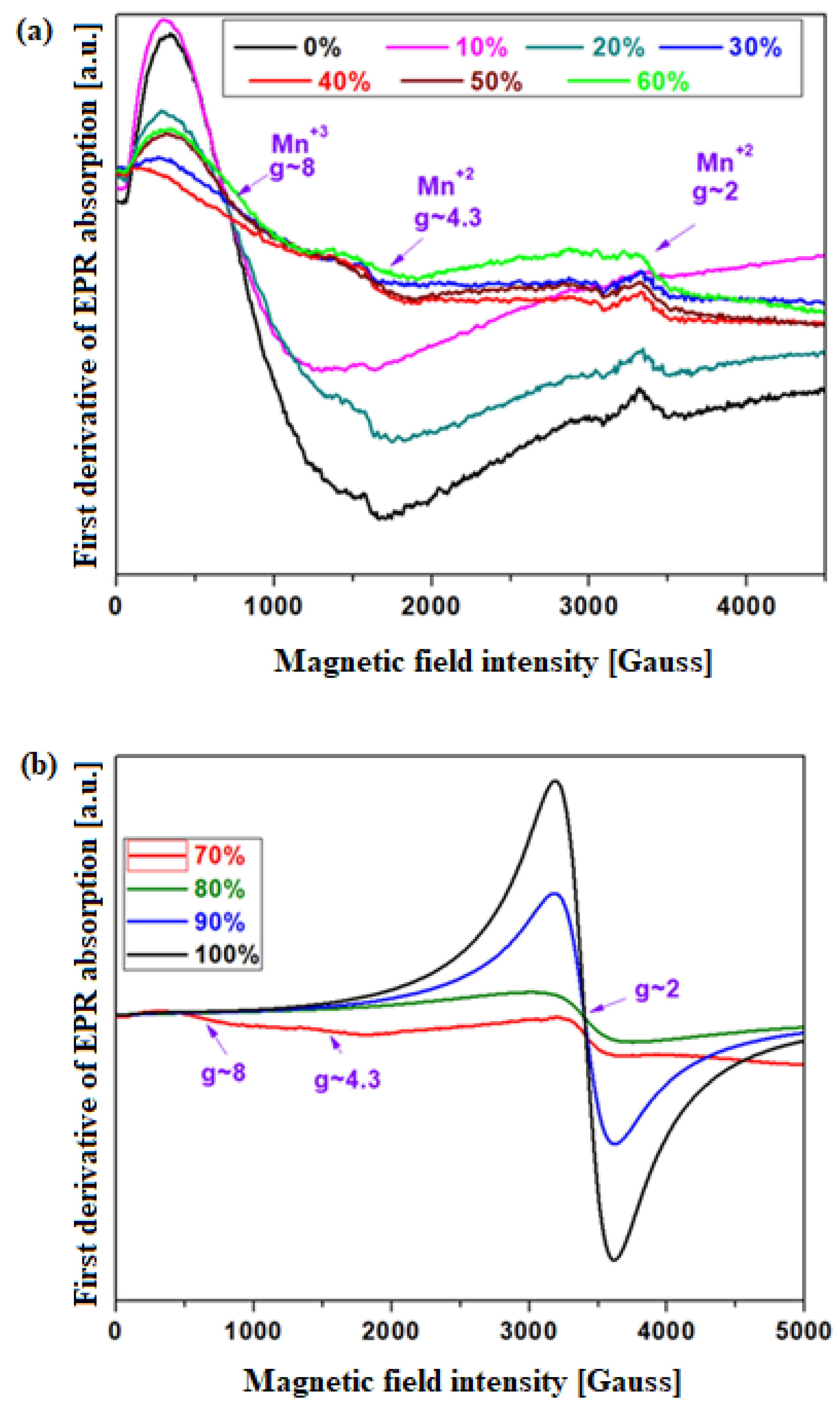
| Notation of MnO2-xLead Vitroceramic Materials | Composition of MnO2-xLead Vitroceramic Materials |
|---|---|
| 0.15MnO2·0.85[(1−x)PbO2·xPb] | |
| x = 0 mol% Pb | 0.15MnO2·0.85PbO2 |
| x = 10 mol% Pb | 0.15MnO2·0.85[0.9PbO2·0.1Pb] |
| x = 20 mol% Pb | 0.15MnO2·0.85[0.8PbO2·0.2Pb] |
| x = 30 mol% Pb | 0.15MnO2·0.85[0.7PbO2·0.3Pb] |
| x = 40 mol% Pb | 0.15MnO2·0.85[0.6PbO2·0.4Pb] |
| x = 50 mol% Pb | 0.15MnO2·0.85[0.5PbO2·0.5Pb] |
| x = 60 mol% Pb | 0.15MnO2·0.85[0.4PbO2·0.6Pb] |
| x = 70 mol% Pb | 0.15MnO2·0.85[0.3PbO2·0.7Pb] |
| x = 80 mol% Pb | 0.15MnO2·0.85[0.2PbO2·0.8Pb] |
| x = 90 mol% Pb | 0.15MnO2·0.85[0.1PbO2·0.9Pb] |
| x = 100 mol% Pb | 0.15MnO2·0.85Pb |
| Wave Number [cm−1] | IR Band Assignment |
|---|---|
| 370–400 | Stretching (elongation) vibrations of the Mn+3-O bond |
| 470 | Deformation (bending) vibrations of Pb-O-Pb and O-Pb-O angles in [PbO4] structural units |
| 480 | Deformation vibrations of O-Mn-O angles in octahedral [MnO6] structural units |
| 520 | Specific vibrations of different types of Mn-O bonds in distorted octahedra |
| 580–600 | Vibrations specific to Mn-O-Mn type bonds |
| 650–850 | Elongation vibrations of the Pb-O bond in [PbOn] structural units where n = 3 and 4 |
| 875 | Elongation vibrations of the Pb-O bond in [PbO6] structural units |
| 900–1100 | Elongation vibrations of the Pb-O bond in [PbO3] structural units |
| Samples | Positions and Integral Intensity of the IR Peaks | ||||||
|---|---|---|---|---|---|---|---|
| Assignments of the Detected Peaks | Pb-O-Pb | [MnO6] | Mn-O-Mn | [PbOn] | [PbO6] | [PbO3] | |
| x = 0% | C [cm−1] A [a.u.] | 476 5.75 | 550 2.28 | 554 0.21 | 688 0.83 | 870 6.005 | 892 12.26 |
| x = 10% | C [cm−1] A [a.u.] | 475 6 | 520 3 | 581 3 | 680 2 | 840 10 | 923 15 |
| x = 20% | C [cm−1] A [a.u.] | 462 1.44 | 520 8 | 580 1 | 700 3 | 832 19.32 | 913 26.31 |
| x = 30% | C [cm−1] A [a.u.] | 470 6 | 520 4.1 | 688 4.5 | 752 2.22 | 870 12.01 | 950 16.03 |
| x = 40% | C [cm−1] A [a.u.] | 470.2 6.01 | 520 4.1 | 689 4.55 | 752.3 2.23 | 870 20.22 | 950 16.05 |
| x = 50% | C [cm−1] A [a.u.] | 470 7.11 | 553 4.56 | 600 1.01 | 778 5.15 | 870 25.55 | 970 2.02 |
| x = 60% | C [cm−1] A [a.u.] | 476 7.88 | 520 5.55 | 590 6.56 | 700 2.34 | 870 19.9 | 950 22.43 |
| x = 70% | C [cm−1] A [a.u.] | 475 8.88 | 520 4.55 | 600 1.54 | 680 10.66 | 875 16.78 | 970 23.45 |
| x= 80% | C [cm−1] A [a.u.] | 470 9.98 | 550 12.33 | 600 1.12 | 785 15.5 | 870 27.7 | 950 33.5 |
| x = 90% | C [cm−1] A [a.u.] | 486 7.78 | 520 14.89 | 600 2.3 | 720 1.12 | 877 28.9 | 950 40.5 |
| x = 100% | C [cm−1] A [a.u.] | 475 2.34 | 520 3.44 | 585 2.11 | 750 1.11 | 875 23.67 | 950 42.30 |
Publisher’s Note: MDPI stays neutral with regard to jurisdictional claims in published maps and institutional affiliations. |
© 2022 by the authors. Licensee MDPI, Basel, Switzerland. This article is an open access article distributed under the terms and conditions of the Creative Commons Attribution (CC BY) license (https://creativecommons.org/licenses/by/4.0/).
Share and Cite
Rada, S.; Unguresan, M.; Zagrai, M.; Popa, A. Structural, Optical, and Magnetic Studies of the Metallic Lead Effect on MnO2-Pb-PbO2 Vitroceramics. Materials 2022, 15, 8061. https://doi.org/10.3390/ma15228061
Rada S, Unguresan M, Zagrai M, Popa A. Structural, Optical, and Magnetic Studies of the Metallic Lead Effect on MnO2-Pb-PbO2 Vitroceramics. Materials. 2022; 15(22):8061. https://doi.org/10.3390/ma15228061
Chicago/Turabian StyleRada, Simona, Mihaela Unguresan, Mioara Zagrai, and Adriana Popa. 2022. "Structural, Optical, and Magnetic Studies of the Metallic Lead Effect on MnO2-Pb-PbO2 Vitroceramics" Materials 15, no. 22: 8061. https://doi.org/10.3390/ma15228061






